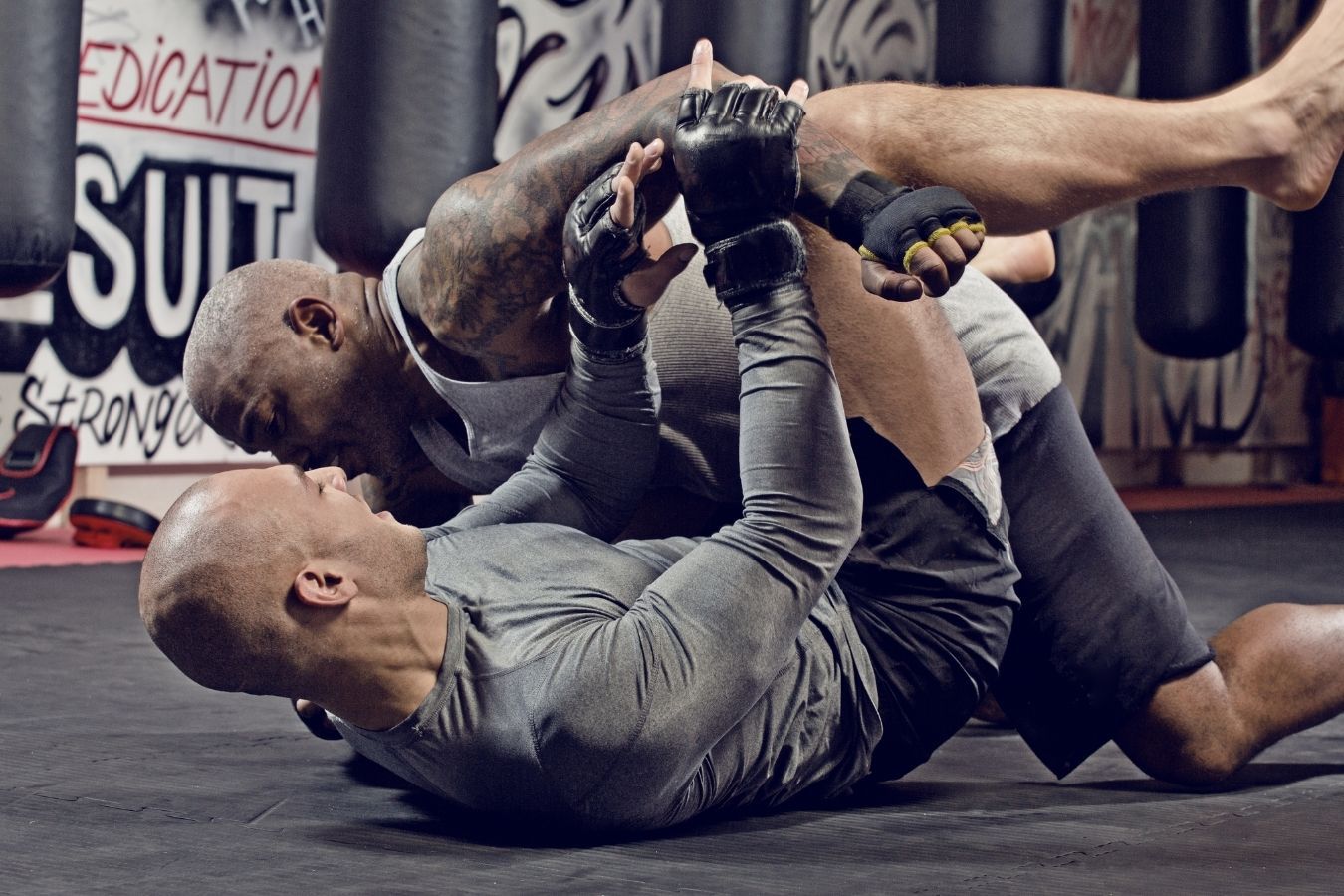Out of all combat sports, MMA is the hardest to schedule training for. Boxing, Muay Thai, Wrestling, Jiu-Jitsu, strength, and conditioning all need to be fit into a training week. The biggest mistake you can make is going hard every day. The incurring fatigue will hamper the quality of your sessions and eventually lead to injury.
Following a High/Low periodization approach where similar training stressors are placed on the same day is an ideal way of scheduling MMA training. Each day should alternate between high and low-stress training days to maximize the quality of sessions and allow adequate recovery.
With all of the different styles of martial arts that need to be trained, how often do you need to train as an MMA fighter?
Do MMA Fighters Train Twice A Day?

Like most professional sports, MMA fighters train twice a day. Sometimes often three times a day [1]. This is the only way to fit in all of the technical and physical training sessions required to compete at a high level in MMA.
Even as a beginner, you’ll have to train twice a day some days in order to fit your strength training.
How Many Times A Week Should You Train MMA?
While this will depend on your schedule, professional MMA fighters train up to 14-15 times a week [1,2]. This will take approximately 16-18 hours of training time. Up to 10 of these sessions will be technical or sparring sessions with the rest making up strength and conditioning sessions.
How Do You Organize Your MMA Training Week?

“Proper planning and practice prevents piss poor performance.” This simple quote identifies the importance of planning your MMA training week correctly.
By correctly, I don’t mean there is only one way of doing so. Your schedule may differ based on what you need to work on, your hours available, if you work full-time, if you’re a professional MMA fighter, or if you only have certain set hours you can train.

How to Dominate Every Fight with Raw, Explosive Power No One Can Match
Discover the underground blueprint that has quietly turned MMA hopefuls into legends, using nothing but sheer, brute force and bulletproof conditioning techniques.
Most important is the principle behind the weekly training schedule. The concept follows the same structure as when balancing weight training and BJJ.
I prefer to use the High/Low training system made famous by great sprint coach Charlie Francis coupled with a Vertical Integration system with all of my athletes that compete in mixed sports (sports that require a mixture of physical qualities to be successful).
The concept of microdosing (no, not magic mushrooms) will also make its way into this training schedule. We cover a lot of this with William Wayland in our podcast below:
These buzzwords may sound confusing but are just fancy names for very simple concepts. The High/Low system is about placing types of training that place similar stress on the body on the same day.
So all high-stress training will occur on one day, and all low-stress exercises will occur on another day.
Here is how you would categorize different MMA training sessions into high and low training stressors:
High Stress | Low Stress |
|---|---|
Hard Rolling | Drilling |
Hard Sparring | Flow/Light Sparring |
Positional Sparring (could be considered low depending on duration and position) | Flow Rolling |
Takedowns/Hard Wrestling | Aerobic conditioning |
Hard Bag/Pad Work | Technical Pad/Bag Work |
High velocity strength, aka power (jumps, plyometric) | Prehab/rehab/mobility exercise |
Sprints (including cardio equipment) | Complete rest |
Anaerobic Lactic Conditioning | Cell |
Vertical integration is simply training all physical qualities during a training week and/or training session. Instead of performing an 8-week block of hypertrophy-only training, you’d train all physical qualities such as strength, speed, and power but you would emphasize hypertrophy over the other qualities if that was your main goal.
The same goes with conditioning, performing long blocks of long duration, steady-state cardio without training speed and power will take away from those qualities.
So why Vertical Integration? Because an MMA athlete can’t get too far away from the ability to display strength, speed, and power. MMA requires high levels of strength to be effective in wrestling, but at the same time needs high levels of speed to throw various strikes.
Microdosing is about sprinkling small amounts of work as often as possible to accumulate volume throughout a week. Rather than trying to find an extra hour to perform aerobic conditioning, we can fit 3 x 20-minute sessions after training sessions.
With these concepts in mind, here is how you could schedule your training week for MMA when not in fight camp:
Monday (Low)
Session 1: Technical/Drilling + 20 minutes MMA specific cardiac output
Session 2: Technical/Drilling/Flow Sparring (10-20 min warm-up “prehab/robustness” exercises)
Session 3: MMA specific or off-feet cardiac power or tempo intervals
Tuesday (High)
Session 1: Strength/Power Training
Session 2: Heavy Pad/Bag work
Session 3: Live Rolling/Grappling
Wednesday (Low)
Session 1: Technical/Drilling + 20 minutes MMA specific cardiac output
Thursday (High)
Session 1: Strength/Power Training
Session 2: Heavy Striking/Grappling
Friday (Low)
Session 1: Technical/Drilling + 20 minutes MMA specific cardiac output
Session 2: Technical/Drilling/Flow Sparring (10-20 min warm-up “prehab/robustness” exercises)
Saturday (High)
Session 1: MMA Sparring/Live Scenarios
MMA Training Schedule For Beginners

As a beginner, you won’t be able to run the above schedule. You have other commitments that are more important in your life such as making a living. Further, you won’t be able to pick your training times as that will be dictated by your gym.
In that case, an MMA schedule for a beginner may be modified like this:
Monday (Low)
Session 1: Solo MMA or off-feet cardiac output circuit or tempo intervals
Session 2: Technical/Drilling/Flow Sparring (10-20 min warm-up “prehab/robustness” exercises)
Tuesday (High)
Session 1: Strength/Power Training
Session 2: Heavy Pad/Bag work/Live scenarios/Rolling
Wednesday (Low)
Session 1: OFF or Easy bodybuilding style training or Cardiac output
Thursday (High)
Session 1: Strength/Power Training
Session 2: Heavy Pad/Bag work/Live scenarios/Rolling
Friday (Low)
Session 1: Solo MMA or off-feet cardiac output circuit or tempo intervals
Session 2: Technical/Drilling/Flow Sparring (10-20 min warm-up “prehab/robustness” exercises)
Saturday (High)
Session 1: MMA Sparring/Live Scenarios
Being a beginner still requires you to train twice a day most days. However, one of the sessions will be away from MMA technical training with coaches and performed on your own or in the gym.
It’s important to note that these schedules aren’t set in stone. They need to be manipulated to your situation and what you need to work on.
For example, those with no scheduled fight who are moving up a weight class may trade some technical training sessions for hypertrophy training.
Whereas those who are close to a fight will be starting to taper and reducing their overall training volume.
Summary
While it's not always possible, it's important to polarize your MMA training schedule as much as possible. This means having high output high days followed by lower intensity days for recovery.
Biggest, Baddest Gas Tank In Just 8 Weeks
Dominate The Cage is specifically designed to develop elite level MMA cardio based on your easy to implement test results


References
1. Tota, Ł., Drwal, T., Maciejczyk, M., Szyguła, Z., Pilch, W., Pałka, T., & Lech, G. (2014). EFFECTS OF ORIGINAL PHYSICAL TRAINING PROGRAM ON CHANGES IN BODY COMPOSITION, UPPER LIMB PEAK POWER AND AEROBIC PERFORMANCE OF A MIXED MARTIAL ARTS FIGHTER. Medicina Sportiva, 18(2).
2. Lovell, D. I., Bousson, M., & McLellan, C. (2013). The use of performance tests for the physiological monitoring of training in combat sports: A case study of a world ranked mixed martial arts fighter. J Athl Enhancement, 2(1), 2-6.

